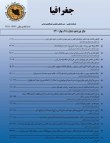Estimation of Lake Urmia water area using Landsat 8 satellite imagery using MNDWI Index
Author(s):
Article Type:
Research/Original Article (دارای رتبه معتبر)
Abstract:
Extended AbstractIntroductionRemote sensing is the science and art of obtaining information about the earth's surface without physical contact with it. This is done by measuring and recording the energy reflected or emitted from the ground and processing, analyzing and using this information. One of the effective tools in the field of environmental studies and earth sciences is the use of remote sensing technology and the use of satellite data. Today's measurement technology has made it possible for geoscientists to use satellite imagery and the processing that takes place on these images to provide the information needed to better understand and detect changes in the human environment. Identify the planet Earth. Monitoring and extraction of changes in the water level of Lake Urmia in recent years has been considered. One of the effective tools in the field of shoreline changes and its area is the use of remote sensing technology and the use of satellite data. The use of satellite imagery due to its large spatial coverage, high resolution, low cost, time archive, free access to satellite imagery and the existence of applications and applied spectral indicators, became very important in studies of estimating the area of water areas. MethodologyIn this paper, the water area of Lake Urmia was calculated by remote sensing and processing of satellite images. Images of the Landsat 8 satellite with pass number 169 and row number 34, which corresponded to 20/05/2021 at 7:38:14, were downloaded from the website of the United States Geological Survey https://earthexplorer.usgs.gov. The Landsat satellite has two imaging sensors. One is the OLI sensor and the other is the TIRS sensor. The OLI sensor has 9 spectral bands in the visible and infrared reflectance range. The TIRS sensor also has two thermal bands. After downloading the Landsat 8 satellite images, it was cut in ENVI software version 3.5 of the Urmia Lake area. The error of the satellite images was eliminated radiometrically and geometrically. In order to improve the spatial resolution of the study area, the 30-meter pixel image was converted to a 15-meter pixel size to improve the resolution of the study area, then atmospheric correction was applied to the satellite image. There are different spectral indices for water zones, the index that was used for the water zones of Lake Urmia is the Modified Normalized Difference Water Index (MNDWI). To investigate the area of Lake Urmia, the output of Shipe File was done in ENVI. The output file of the file slope was called in Arc Map and the area of Lake Urmia was calculated in terms of square kilometers. Results and DiscussionOne of the methods used in remote sensing to identify phenomena is the use of spectral index. Many studies and researches have been done in the past that the water zone has been separated from other phenomena. The NDWI Index, also known as the Water Index, was first introduced by Gao in 1995. Another indicator was later used in 2005 by Denison et al. To measure plant moisture. A year later, McFithers (1996) introduced NDWI, a combination of green and near-infrared bands, in another study on the separation and detection of blue zones. In 2003, Chen et al. In a study of plant moisture content presented a new indicator that combines near-infrared and short-wavelength infrared bands. In 2006, with a slight change from previous algorithms, Zhou replaced the mid-infrared band with the near-infrared band and introduced a new indicator. The corrected NDWI index presented by Zhou has been used in various studies only in the field of identification and extraction of water areas. Index (MNDWI) separates the Urmia Lake area from other coverings. In this index, there is water in some places. Its NDWI value is different from the places where it is white and wet salt marshes. In the water zone, the index reaches 0.99, but in wet salt marshes it reaches 0.6. Is higher. In this index, the positive numbers are between (0.6-1) water areas, the numbers are 0 and negative are other vegetation. The spectral behavior of water is different from other indicators, it has the highest amount of reflection in the blue band, from the blue band to longer wavelengths, ie infrared, it increases the absorption rate, and consequently the reflection decreases. ConclusionTo investigate the area of Lake Urmia, the output of Shipe File was done in ENVI. The output file of the file slope was called in Arc Map and the area of Lake Urmia was calculated in terms of square kilometers. According to Landsat satellite images with ROI values between 1 to 0.2 percent, the area of Lake Urmia on the date of the images, which were downloaded on 20/05/2021, has been calculated to be 3,107,844 square kilometers.
Keywords:
Language:
Persian
Published:
Geography, Volume:20 Issue: 74, 2022
Pages:
165 to 186
https://magiran.com/p2528289
دانلود و مطالعه متن این مقاله با یکی از روشهای زیر امکان پذیر است:
اشتراک شخصی
با عضویت و پرداخت آنلاین حق اشتراک یکساله به مبلغ 1,390,000ريال میتوانید 70 عنوان مطلب دانلود کنید!
اشتراک سازمانی
به کتابخانه دانشگاه یا محل کار خود پیشنهاد کنید تا اشتراک سازمانی این پایگاه را برای دسترسی نامحدود همه کاربران به متن مطالب تهیه نمایند!
توجه!
- حق عضویت دریافتی صرف حمایت از نشریات عضو و نگهداری، تکمیل و توسعه مگیران میشود.
- پرداخت حق اشتراک و دانلود مقالات اجازه بازنشر آن در سایر رسانههای چاپی و دیجیتال را به کاربر نمیدهد.
In order to view content subscription is required
Personal subscription
Subscribe magiran.com for 70 € euros via PayPal and download 70 articles during a year.
Organization subscription
Please contact us to subscribe your university or library for unlimited access!


